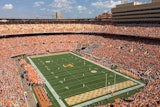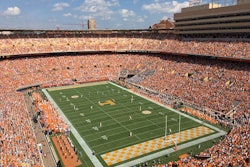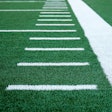Unlike most land plots at the University of Missouri's research farms, one of the newest isn't growing anything. Instead, the lush, green sections represent five different brands of synthetic turf. "Testing these synthetic turfs will allow us to answer ongoing questions about hardness, heat syringing and bacterial growth," says Brad Fresenburg, an MU Extension turf scientist.
One of the most looming questions is whether bacteria exists in the type of surface material that has become increasingly popular at the high school levels. "At this point, we simply don't know," Fresenburg says. While summer heat may stymie bacterial growth, spring and fall temperatures in Missouri may be ideal for such growth. And sweat, spit and blood from athletes may help infectious bacteria thrive.
The land plot, featuring 15-by-20-foot sections of five popular turf brands, was unveiled recently on a site in Columbia that provides a randomized block design for conducting research trials, as well as an area for grooming, cleaning, painting and paint-removal demonstrations. The turf sections were installed on a six-inch gravel bed over flat drains and top-dressed according to manufacturers' installation guidelines, and the plot was placed next to a large section of natural grasses for research comparisons. Manufacturers and distributors donated the turf samples and other materials (including crumb rubber), Fresenburg says.




































